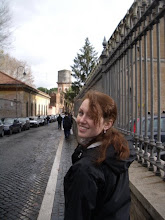Rome is a city long famous for spectacle and tradition, and I've written before about both religious festivals and secular parades (my last post was about an event both religious and spectacular!), but I would now like to introduce you to a celebration that has only recently been revived here in Rome: The Girandola.
I should mention that today, June 29th, is the Feast of St. Peter and St. Paul, one of the largest and most important Catholic feast days in Rome, but that the Girandola (though always held on the eve of this day) actually commemorates another religious event: the appearance of the Archangel Michael above what was at the time known as the Mausoleum of Hadrian, and is now more commonly called the Castel Sant'Angelo. In fact, the renaming of the building was thanks to this vision of the 'Holy Angel', who appeared in the sky over the Castel sheathing his sword, thus ending the plague of AD 590. While the appearance (and the end of the plague!) were widely celebrated in the 6th century, the Girandola came into existence in the 15th century, under the pontificate of Sixtus IV (you may know him better as the Pope who built the eponymous Sistine Chapel). Expanded and enhanced under his nephew, Pope Julius II, the spectacle continued to be celebrated annually until the 18th century, when it was slowly abandoned. Three years ago, however, the Roman city government decided that this was one tradition that should have its own renaissance.
So by now, you may be asking, 'What exactly IS the Girandola?' Well, girandola means 'turning' in Italian, but what they're referring to is the turning of hundreds of pyrotechnic devices. That's right- the Girandola is Rome's largest fireworks show. And as if that weren't enough, the show they still put on was designed by Michelangelo himself, with later additions by Gian Lorenzo Bernini. During the actual Renaissance, it took almost 200 men to 'turn' the fireworks and launch them into the sky, but now it takes a team of 15 professional pyrotechnicians, who (in addition to years of work in the field of fireworks shows) study Michelangelo's original designs, plans, and flourishes for the show for 2 months prior to the performance of the Girandola.
The resulting spectacle is therefore not only a profusion of loud and sparkling lights in the Roman sky, but a solid link to Renaissance Rome, and one of the greatest periods of art and culture in the Eternal City. When you are taking your direction from two of the greatest artists ever to grace this city with their geniuses (not JUST Michelangelo, but Bernini too!), it is hard to go wrong, and my friends and I watched the show in a crowd of hundreds, lining the bridges and embankments along the Tiber. Here is a video taken from the riverbank just south of the Castel Sant'Angelo. If you speak or understand Italian, have a laugh at the filmmakers, who politely applaud the beauty of the fireworks ('Che bello!') and then quickly express dismay at the pause before the next set of them ('eh, brutta')...
Tuesday, June 29, 2010
Subscribe to:
Post Comments (Atom)

No comments:
Post a Comment